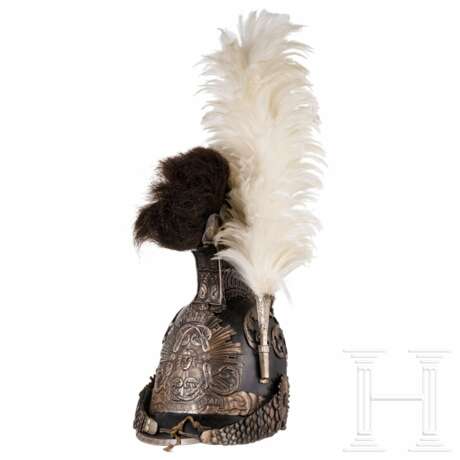ID 1325745
Lot 265 | Helm M 1814 der Gardes du Corps du Roi aus der Regierungszeit Ludwigs XVIII.
Hohe Glocke aus zwei über dem Scheitel vernähten Teilen aus derbem, schwarz lackiertem Leder mit reichen Beschlägen aus versilbertem Kupferblech. Stirnseitig der große Stern mit dem "visage du soleil rayonnant" (strahlende Apollomaske) im Zentrum, eingefasst in das bekrönte Spiegelmonogramm "L" von König Ludwig XVIII., darunter das Bandeau "Nec pluribus impar" ("Auch nicht mehreren unterlegen"). Große, mehrgliedrige Schuppenketten (schwarzes Samtfutter) an strahlenförmigen Rosetten mit Apollomaske. Hoher, fein reliefierter Kamm (Feder- und Blattmotive) mit schwarzer Rosshaarraupe. An den Seitenflächen der Glocke elegant geschwungene Hiebspangen in floralem Muster, auf der linken Seite die Tülle, darin eingesteckt ein hoher weißer Federbusch. Innen ein breites Schweißband aus schwarzem Leder (Fehlstellen), daran Reste des angenähten, geschwärzten Seidenfutters. Größe ca. 52. Teilweise beschädigt, Altersspuren.
Seltener Helm einer Eliteeinheit des französischen Königs von hoher historischer Bedeutung!
Bei den "Gardes du Corps du Roi" handelte es sich um die Leibgarde des französischen Königs. Zugang zu dieser hatten nur Angehörige des Adels und Bürger aus sehr gut situierten Häusern. Es bestanden nur vier Kompanien, die in Versailles stationiert waren. 1791 wurden die Gardes du Corps du Roi aufgelöst. Als Standarte führten die Kompanien eine Fahne mit der "soleil rayonnant".
Das Motto "Nec pluribus impar" geht auf den Sonnenkönig zurück, der hiermit sein Wappen schmückte, es wurde aber auch auf den Feldzeichen der Armee geführt.
Nach dem Vertrag von Fontainebleau und der Abdankung und Verbannung Kaiser Napoleons kehrte der Enkel König Ludwigs XV. und Bruder König Ludwigs XVI. nach seinem Exil in England als König nach Frankreich zurück. 1814 wurden auch die Gardes du Corps du Roi wieder aufgestellt. 1815 verließ der König nach der Landung Napoleons Paris fluchtartig, konnte aber nach der Niederlage Napoleons bei Waterloo wieder zurückkehren.
A helmet M 1814 of the Gardes du Corps du Roi from the reign of Louis XVIII
A helmet M 1814 of the Gardes du Corps du Roi from the reign of Louis XVIII
High skull made of coarse, black lacquered leather, the two halves stitched together at the crown, with opulent mounts of silver-plated sheet copper. On the front, the large star with the "visage du soleil rayonnant" (Apollo mask within rays of sunlight) at the centre, enclosed in the crowned, intertwined monogram "L" for Louis XVIII, below which the banner "Nec pluribus impar" (literally: "Not unequal to many"). Large, multi-part chinscales (black velvet underlay) on ray-shaped rosettes with an Apollo mask. High comb in fine relief (feather and leaf motifs) with a black horsehair crest. Elegantly curved protective bars arranged in a floral pattern on the side panels of the skull, the socket on the left with a high white plume inserted into it. The inside with a broad sweatband in black leather (imperfections), with remnants of the blackened silk lining still attached. Size approximately 52. Damaged in places, signs of age. Remarkable helmet worn by an elite unit of the French King.
Of enormous historical significance.
The "Gardes du Corps du Roi" served as the French King's bodyguard. The unit only admitted members of the nobility and citizens from very well-to-do families. There were only four companies, which were stationed in Versailles. The Gardes du Corps du Roi were disbanded in 1791. As a standard, the companies carried a flag with the "soleil rayonnant".
The motto "Nec pluribus impar" was adopted by the Sun King, adding it to his coat of arms; however, it was also displayed on the field insignia of his army.
After the Treaty of Fontainebleau and the abdication and banishment of Emperor Napoleon, the grandson of Louis XV and brother of Louis XVI returned to France as King, following his exile in England. In 1814, the Gardes du Corps du Roi were also re-established. In 1815, after the landing of Napoleon, the King fled Paris but returned after Napoleon's defeat at Waterloo.
Condition: II - III
| Auction house category: | France, Time of the Restoration |
|---|
| Auction house category: | France, Time of the Restoration |
|---|
| Address of auction |
Hermann Historica Bretonischer Ring 3 85630 Grasbrunn / München Germany | ||||||||||||||
|---|---|---|---|---|---|---|---|---|---|---|---|---|---|---|---|
| Preview | |||||||||||||||
| Phone | +49 (0)89 5472 649 0 | ||||||||||||||
| Fax | +49 (0)89 5472 64999 | ||||||||||||||
| Buyer Premium | 25 % | ||||||||||||||
| Conditions of purchase | Conditions of purchase | ||||||||||||||
| Business hours | Business hours
|



